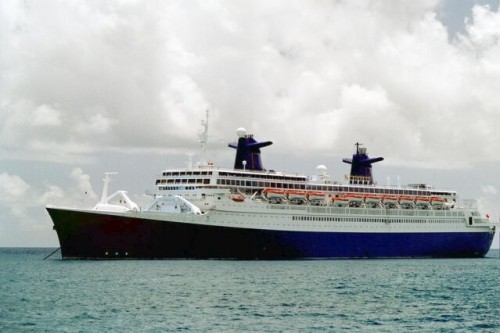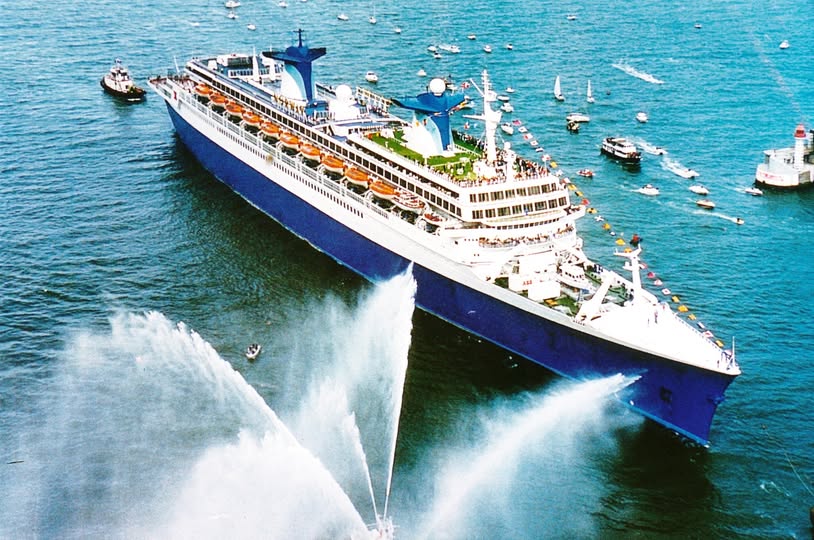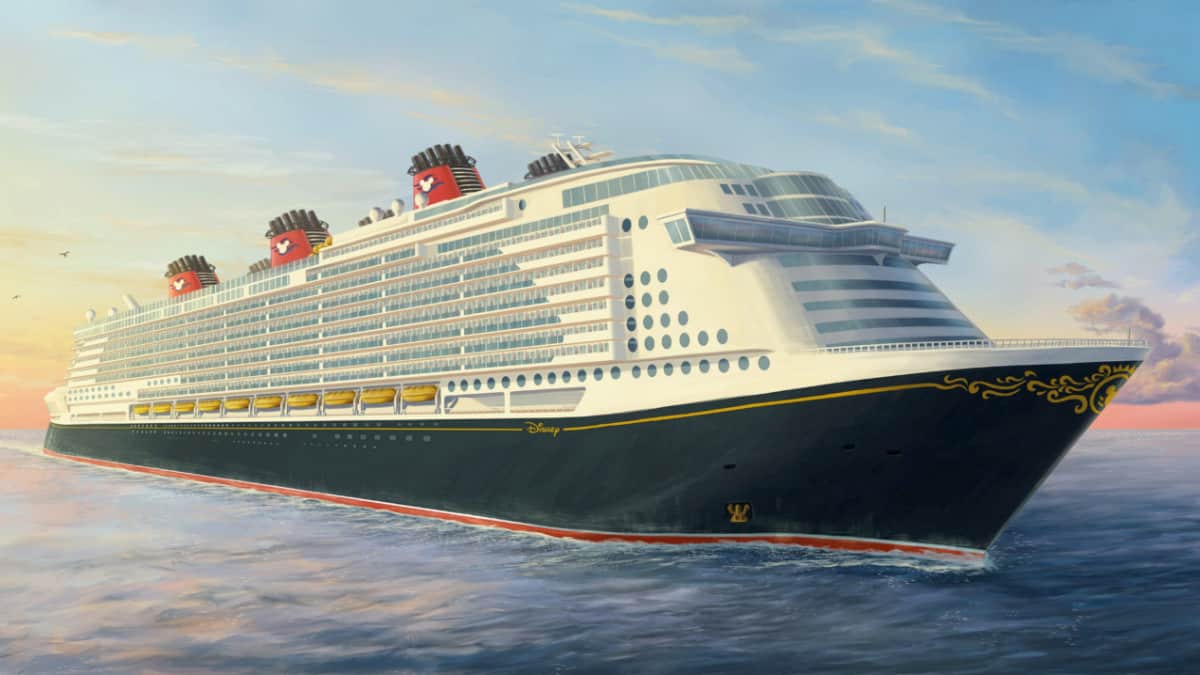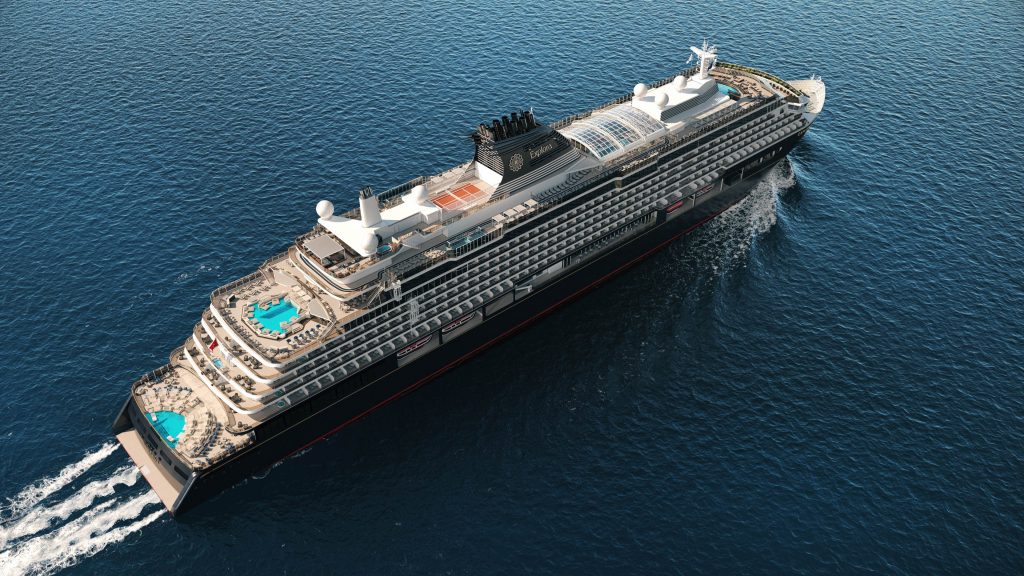In July 1984, I made my first short trip on a “mega cruise ship”, at the time even the world’s largest and longest cruise ship, the Norway. We sailed from Southampton to Amsterdam, and we had full day at sea to explore the ship. In those days, the only ship matching her in size was the Cunard Line’s famous Queen Elizabeth 2. As it happened, she also was in the port of Southampton on july 25th. Thousands of onlookers had come tot the docks to see both vessels and when the Norway and the Queen greeted each other by blowing their horns, this was an occaision no shiplover will easily forget.

When I came out on deck the following morning, I sensed there was something strange happening, but I did not realize what it was at first. Then I noticed that we had come to a halt at sea! Later, it was rumoured that the Norway’s master had given orders to stop her at sea, rather than letting her proceed at slow speed as he thought it was undignifying for a once transatlantic speed queen, to let her crawl to Amsterdam. So we floated around for some time before Norway gradually started picking up speed again. When we entered the locks of IJmuiden at 02.00 AM, again many spectators were present and all cars switched on their headlights. A very spectacular sight!

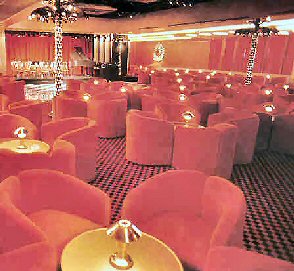
The first class salon Fontainebleau (left) on the France was later turned into the Checkers Nightclub (right) on the Norway
History
Norway started her career on the high seas as the French transatlantic liner France in 1962. One of the last of her kind as the airplane had completely taken over. Only a handful of liners remained on the route to New York, but before the 1970’s, almost all of these were gone. They either ended their days at the scrapyard or switched to cruising. France was the longest passenger ship ever built: 315.5 metres, a title she held until January 2004, when the Queen Mary 2 was taken into service. France made almost 400 transatlantic crossings between Le Havre and New York, during her short career (12 years) as a liner. In 1974, the French government decided to cut operating subsidies and although her crew tried to prevent her being taken out of service by blocking the port of Le Havre with the France, she was sent to lay up at the Quai de l’Oublie (quay of the forgotten) at Le Havre.
She spent five years there, silent and indeed forgotten. Then an Arab businessman, Akram Ojjeh bought her in 1979 and rumours concerning her future started circulating: one said she would be used as a gambling hotel in the US, and that Mr. Ojjeh already had already purchased loads of antique furniture to be placed on board. Alas, it didn’t come to pass….

In a surprise move, in 1979 Knut Kloster, owner of Norwegian Caribbean Line, a firm that had pioneered cruising in the Caribbean with their first vessel Sunward, bought the idle France. At the time, the ideal tonnage for a cruise ship was thought to be in the 25.000 – 30.000 GRT range, and the cruise industry looked upon Klosters plans with great scepticism. Unabashed, Kloster sent the France to the German Lloyd-Werft and spent $45 mio on her to convert her from a closed liner to an open cruise ship with large sun decks and outside swimming pools.
Her profile remained more or less the same, apart from an enlarged sun deck at the stern. Her indoor pool disappeared, two outer pools were added and her machinery was downgraded from four to two steam turbines in order to achieve more fuel efficiency. After an 8 month refit she was delivered by Lloyd Werft and set out on her maiden voyage in 1980 under her new name Norway. She proved to be a great commercial success, and the new age of the mega cruise ship had begun!
It took competitor Royal Caribbean Cruise Lines seven years to respond by taking the Sovereign of the Seas into service in 1987. She was the first purpose built mega cruise ship, measuring 73.192Grt and carrying 2276 passengers.

Norway would stay in the Caribbean for an incredible 23 years . She had left the Caribbean on a number of occaisions to make some cruises in European waters, mostly combined with a refit or overhaul at Lloyd Werft, Germany.
In the ‘80s other companies started to operate large cruise ships, beginning with the already mentioned Sovereign of the Seas. Norway was surpassed in tonnage and NCL sent her to Lloyd Werft again for an extensive refit. To regain the title of being the world’s largest cruise ship and to enlarge her earning capacity, two decks were added on top of her superstructure. Now an extra 135 luxury cabins were available. Norway “grew” to around 75.000 GRT in the process. Her profile was altered somewhat, happily it was not spoiled as only her funnels seemed to be shortened. The new decks were built around the existing funnels.
Speaking of Norway’s profile, on her forecastle two 24 mtr long barges were added during her conversion to cruise ship, appropiately called Little Norway I and II. Her deep draught of over 10 mtr makes it impossible for Norway to dock in most ports, so passengers have to be tendered ashore. Both of these tenders have large passenger carrying capacities.

Norway – interiors
As far as cabins are concerned, there was a mixture of cabins available in many categories, ranging form small inside cabin which had become a bit outdated over the years (and were reminiscent of her ocean liner days) to luxury outside cabins which had been upgraded. To this the 135 cabins we already mentioned on her new top decks were added. These reflected the latest standard of luxury in the cruise business, some even had balconies.
Norway had two dining rooms, Leeward and Windward. The Leeward was a two level dining room with interconnecting stairs featuring an enormous chandelier, which was transformed from the former Restaurant Versailles which really was a rather simple and cold dining room.
The Windward dining room had been left virtually unaltered. It had a circular form, and featured a grand staircase from which passengers could make a dramatic entrance into the dining room. Original murals and grandiose wood-panneling have been retained over the years, and these added an unmistakable classic charm to this dining room.

Norway featured two enclosed promenades. These were her former first class promenades, which sheltered her passengers from the often angry North Atlantic. It made one dream about the days France made crossing after crossing between Le Have and New York, seeing many celebrities stroll along these promenades…..
They were called Fifth Avenue and Broadway, and they gave access to public rooms on this deck. Norway carried a large number of passengers, meaning that when for example a captain’s cocktail was organised, long lines formed in Champs Elysees and Fifth Avenue. Hoever, NCL had found a clever solution to this: when standing in line passengers were entertained by various artists like magicians, musicians etc.
In fact waiting lines did grew out of proportions when passengers were asked to collect their passports before disembarking. In some cases it took hours before all passports had been returned. This was solved by flying customs officials in by helicopter, so picking up passports could start much earlier, thus avoiding congestion at the desk.

French gloating? Newspaper France Soir reports Norway’s maiden voyage has to be postponed because of plumbing problems
One of the ship’s most impressive public spaces, which must be mentioned here is the former First Class smoking room Salon Riviera, which is largely unaltered from her original appearance. After entering this magnificent room, you have to climb a circular stairway to reach the center part. A perfect place for a drink (there is a small bar) and dancing at night. On both sides there are views on both indoor promenades, and also on the Boat deck, one deck up. Several fixtures, from the ship’s days as France still remain in place, e.g. the ornaments on the ceilings. New in this room are two statues of ancient Gods, both made of semi precious stones, which had to be hoisted aboard by crane! The Club Internationale as its present name is, remains one of the finest rooms afloat, reminiscent of the glory days of ocean travel, and is in the same league as Rotterdam V’s Ritz Carlton Lounge.
In 2001 Plans were announced by NCL to transfer Norway to their subsidiary Orient Line (Orient operates soft expedition cruises). She would as it were switch places with Star Cruises’ (NCL’s parent company) modern cruise vessel Superstar Leo. The Leo in turn would be incorporated in the NCL fleet and sail in US waters while Norway would trade for Orient, trying to open up new markets. Although Superstar Leo was actually transferred to the NCL fleet in 2004 and sailed as Norwegian Spirit in US-waters for a short period, Norway remained in the Caribbean.

Alas, in May 2003, whilst in the port of Miami between two cruises, Norway suffered an explosion in one of her boilers. 8 Crew members were killed in the accident, there were no casualties among passengers. At first, she was expected back in service within a month or two, but repairing the boiler proved to be a lengthy and costly affair as only a few companies have the skills to construct one. She had built up quite an account concerning her “parking fee” in the Port of Miami and it was decided to tow her to Europe to the yard that had given her a new life as a cruise ship, Lloyd Werft in Germany.
Just before the summer of 2004, NCL decided that Norway would not return to their fleet (indeed she was silently removed from NCL’s website), and she was used as a floating hotel for construction workers and future crew members of the brand new Pride of America which was delivered to NCL in June 2005. One of the reasons NCL ended operating the Norway was that the reason why one of the boilers exploded has never been discovered. So theoretically, one of the remaning ones could explode as well and NCL was not willing to endanger their crew members on board.
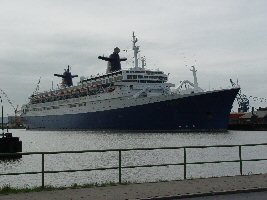
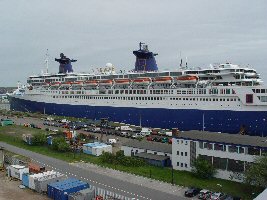
May 2005, Norway at Lloyd Werft just days before she left under tow to Malaysia
In the mean time, several parties seemed to be interested to acquire her for use in a static role, such as a floating hotel and convention center.
Amsterdam and Hamburg and Honfleur (France) were said to be three of these interested parties. However, Lloyd Werft warned for high maintenance costs if Norway was used in a static role.
June 2005, the magazine FEM Business Update announced that a Dutch politician and his business partner, had definitely acquired the Norway for use as a hotel in Amsterdam. This deal must have fallen through as she left Bremerhaven on May 25th to be towed to Port Klang (Malaysia) where she stayed at anchor for 6 months until January 2006. In August she was inspected by Indian and Bangladeshi breakers and renamed Blue Lady. Again, rumours circulated that she would be used as a gambling vessel, operating at slow speed on two of her undamaged turbines, but she was sold to Bangladeshi breakers in December 2005 and departed under tow to Chittagong. Before she reached her final destination however, the sale was cancelled under pressure of Greenpeace and other environmental organisations and Blue Lady returned to Malaysia.
Then, Australian maritime publicist Reuben Goossens started a campaign to save this great vessel together with Blue Ribband/ Gulf Desert LLC and operate her in Dubai as a hotel, restaurant and museum. Blue Lady now headed under tow for Fujerah, UAE, where she remained until the deal fell through.
Blue Lady, once attracting crowds wherever she arrived, now circled the Indian Ocean, as she was denied permission to dock anywhere….. she had become an unwanted vessel.

At last in July she was allowed to enter Indian waters and was finally beached off Alang, after being purchased by Indian shipbreaker Priya Blue. Scrapping the vessel was not yet permitted however, because the Supreme Court of India waited to give permission for this until the outcome of an investigation related to the amount of asbestos on board which could endanger the scrapyard personnel’s health. The court ruled favourably in the autumn of 2007 and at the end of this year the actual scrapping started.
In the mean time, Blue Lady had been dragged closer to shore and her fittings were already offered for sale on the web….. Autumn 2009 this once gracious vessel had almost vanished into memory as she had been scrapped for 80%.

